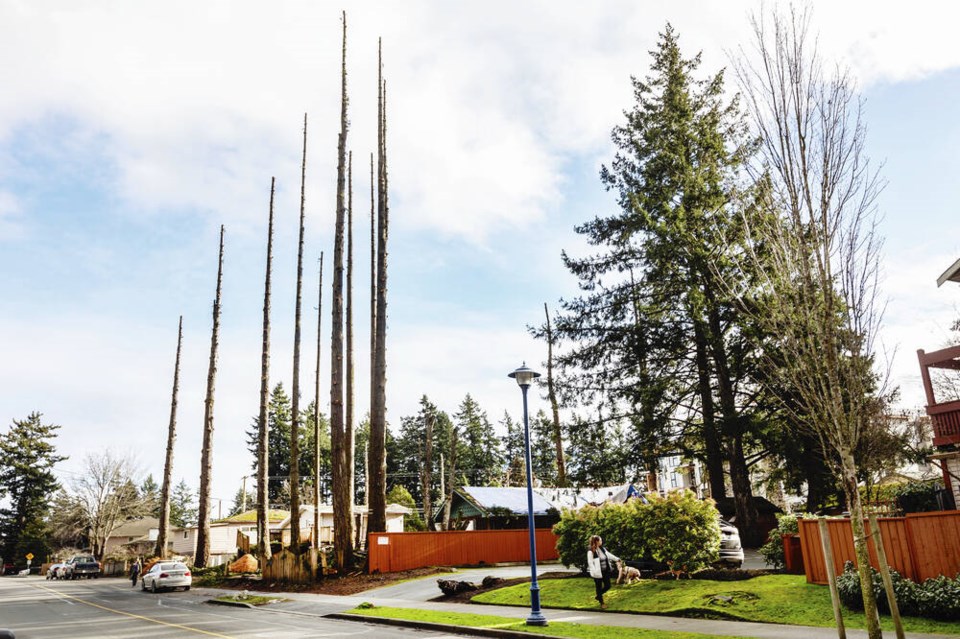Langford council’s fast-tracking of a temporary tree-protection bylaw has drawn plenty of praise, but also criticism over the rushed process and what some felt was a lack of public transparency.
The bylaw came before council just days before Christmas. It was tabled and approved within a 72-hour period, including a hastily scheduled afternoon meeting to accommodate staff and council holidays just as the region was in the middle of a snowstorm. Few made it online or to the chambers to speak on the issue.
Finding itself in a legal grey area over the meeting notices and procedures during the quick approval, council re-approved the bylaw on Monday after an extended public consultation that lasted more than two hours and brought out about two dozen speakers — almost all in favour of the bylaw.
However, the quick turnaround didn’t sit well with some residents, including a lawyer who represents landowners and developers with active projects in Langford.
“Sometimes proceeding without careful thought and review and rushing governance leads to poor outcomes,” John Alexander told council on Monday. “I’m also here to ask for recognition of your election platforms that were based so heavily on adequate notice, adequate consultation and listening to the public.
“If those be applied … perhaps council considers the very real concerns of those who have taken on the risk of investing in your city regarding the impact of these tree-cutting prohibitions being enacted so hastily.”
All the new councillors voted in during last fall’s municipal election had transparent processes and tree protection on their platforms, citing the rapid pace of development and fast-vanishing green spaces and canopies.
But Mayor Scott Goodmanson said council had to act quickly to put tree protections in place after announcing, on Dec. 5, impending plans for a tree management process. Staff brought to Goodmanson’s attention that trees were being removed at a rapid pace at three locations ahead of potential tree protections.
Goodmanson said council was pushed by the sudden surge in tree-cutting. He said in an interview it wasn’t local developers, but a few builders from off the Island.
“This is a temporary tree protection bylaw for six months while we work on a urban tree management plan,” said Goodmanson.
Council directed staff to start a request for proposals for the tree management plan. Funded by the province, it will review existing tree-protection policies, those in other municipalities and develop an inventory of Langford’s urban forest. Public consultations will also be held.
Council gave first, second and third readings on the re-tabled tree protection bylaw on Monday and will vote on final approval of the bylaw at a meeting in February. However, the bylaw as voted prior to Christmas remains.
Goodmanson said the tree-protection bylaw is needed to bring Langford up to date with other urban centres. The city is the only municipality in the Capital Regional District without a specific tree-protection bylaw.
Last June, then-mayor Stew Young rejected a tree-protection bylaw proposal, saying the city’s development permit process already protected trees and environmentally sensitive areas.
About 70% of Langford is within designated development permit areas. Since 2008, the zoning process has stipulated that 40% of each site must be set aside for tree protection and green spaces.
That has already been applied to major projects such as Bear Mountain, South Skirt Mountain and Westhills, where thousands of additional trees have been also been planted.
Last June, a staff report said the development permit process is considered a more comprehensive solution to tree protection “as it allows for whole ecosystems to be considered, not simply a tree-by-tree approach.”
The development permit area protections will remain, said Goodmanson, and Langford’s new bylaw would apply to all properties, including the 30% outside the permit areas, many of them single-family homes.
The bylaw means anyone wanting to remove a tree with a trunk diameter greater than 20 centimetres at a height 1.4 metres above ground needs a city permit.
There are exceptions for trees cut down to adhere to provincial regulations, for city walkways and trails, and tree-cutting authorized under a development permit.
Under the bylaw, the city could seek financial compensation through the courts of up to $10,000 per violation or per tree, while city staff can also impose a fine of $1,000 per violation or per tree without going to court.
One resident questioned the steep fines, saying the penalties exceeded those for having dangerous dogs or polluting the environment with dangerous goods.
Others said the bylaw will hurt ordinary homeowners who might want to remove a tree that has become too large and potentially dangerous.
But the vast majority of speakers praised council for taking steps to protect trees.
“I want to thank council for taking a bold step to give trees their rightful place as critical municipal infrastructure,” said Kristen Awram of Finlayson Arm Road.
“It’s no different than a need for a sidewalk, road or traffic light. Trees provide us with many vital functions and deserve to be treated with respect and be given pride of place.”
Resident Sarah Plank dismissed the calls for lack of transparency, saying “the highest form of public engagement took place in a democratic election” where a tree-protection bylaw was promised.




